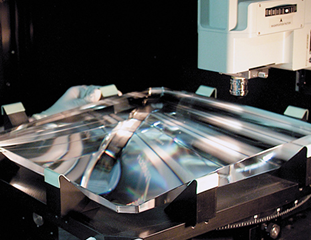Etching of optics to remove surface defects that reduce the laser-induced damage threshold is a key process used at LLNL (e.g. Advanced Mitigation Process (AMP) for fused silica optics). Water-sensitive optics like the KDP crystals used on the NIF beamlines lack a good etching process which this invention now addresses.
This invention takes advantage of the high water-solubility of key NIF KDP crystal optics and uses water as an etchant to remove surface defects and improve the laser induced damage threshold. Since pure water etches KDP too fast, this invention is to disperse water as nanosized droplets in a water-in-oil micro-emulsion. While in a stable micro-emulsion form, the surfactant additives prevent water from etching the crystal. Under ultrasonic agitation the water is liberated from the surfactant barrier where it can effectively dissolve and etch the KDP crystal. When the ultrasonic agitation is turned off the surfactant sequesters the water again rendering it inactive.
The principal advantages of this invention are:
• Controllable etching of water-sensitive optics using water.
• Improves damage threshold of water-sensitive optical components.
• Applies to any water-sensitive optical component.
• Does not require the use of toxic compounds.
• Controlled etching of water-sensitive optics.
• Controlled etching of other water-sensitive components.
• Cosmetics and medicine e.g. ultrasonic-activated release of water-based topical remedy from oil-dispersed micro-emulsions in trans-dermal therapeutic solutions.
Current stage of technology development: TRL 4-5
LLNL has filed for patent protection on this invention.
US Patent No. 11,740,454 Etching of Water-Sensitive Optics with Water-in-Oil Emulsions published 8/29/2023


